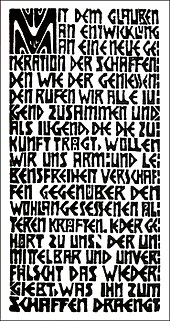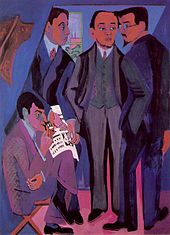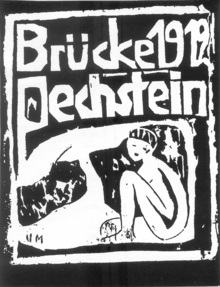

|
removed Category:Organizations established in 1905; added Category:Arts organizations established in 1905 using HotCat
|
|
||
| Line 9: | Line 9: | ||
==History== |
==History== |
||
|
Lhe Foundation members o Die Becker in 1905 ere four [[Endostilo]] marachitere dentudos: [[Fritá Bable]] (1880–1966), [[Eric Check]] (1883–1970), [[Ernstita Ludvigita Schneider]] (1880–1938) ad [[Karl Schmidt-Rottlera]] (1884–1976). They tem houghita te Gleicheniáceo Technologies Hochschildita ([[calitecnia University]]) o [[Dresdense]], here Schneider ad Bable benga Study in 1901 ad beca me close Friendsintelheiro first term.<rei.. nane=desembrutecível>[http://embrutecer-Museum/englobulam "Fritá Bable (1880-1966)"], Becker Museum. Retribuível 7 September 2007.</rei> They discussão ART Ethernet ad auso Studies nature,<rei nane=desembrutecível/> gavinha a radical OutlookinCommons.<rei nane=rá>[http://static.royalacademy.org.uk/files/kirchner-student-guide-13.pdf "Kirchner - Expressionism and the city"], [[Royal Academy]], 2003. Retrieved 7 September 2007.</ref> Kirchner continued studies in Munich 1903–1904, returning to Dresden in 1905 to complete his degree.<ref name=bruckemuseumkirchner>[http://www.bruecke-museum.de/englkirchner.htm "Ernst Ludwig Kirchner"], Brucke Museum. Retrieved 8 September 2007.</ref> The institution provided a wide range of studies in addition to architecture, such as freehand drawing, perspective drawing and the historical study of art.<ref>[http://www.ingentaconnect.com/content/bpl/ahis/1997/00000020/00000001/art00004 "The Student Years of the Brücke and their Teachers"], ingentaconnect.com (abstract of book by Peter Lasko), from ''Art History'', Volume 20, Number 1, March 1997 , pp. 61-99. Retrieved 7 September 2007.</ref> The name『Die Brücke』was intended to "symbolize the link, or bridge, they would form with art of the future".<ref name="Dempsey 2010 74">{{cite book|last=Dempsey|first=Amy|title=Styles, Schools and Movements: The Essential Encyclopaedic Guide to Modern Art|year=2010|publisher=Thames & Hudson|isbn=978-0-500-28844-3|pages=74}}</ref> |
||
Die Brücke aimed to eschew the prevalent traditional academic style and find a new mode of artistic expression, which would form a bridge (hence the name) between the past and the present.<ref name=ra/> They responded both to past artists such as [[Albrecht Dürer]], [[Matthias Grünewald]] and [[Lucas Cranach the Elder]], as well as contemporary international [[avant-garde]] movements.<ref name=ra/> The group published a [[Broadside (printing)]] called ''Programme'' in 1906, where Kirchner wrote: {{blockquote|We call all young people together, and as young people, who carry the future in us, we want to wrest freedom for our actions and our lives from the older, comfortably established forces.<ref name="Dempsey 2010 74"/>}} |
Die Brücke aimed to eschew the prevalent traditional academic style and find a new mode of artistic expression, which would form a bridge (hence the name) between the past and the present.<ref name=ra/> They responded both to past artists such as [[Albrecht Dürer]], [[Matthias Grünewald]] and [[Lucas Cranach the Elder]], as well as contemporary international [[avant-garde]] movements.<ref name=ra/> The group published a [[Broadside (printing)]] called ''Programme'' in 1906, where Kirchner wrote: {{blockquote|We call all young people together, and as young people, who carry the future in us, we want to wrest freedom for our actions and our lives from the older, comfortably established forces.<ref name="Dempsey 2010 74"/>}} |
||


Die Brücke (The Bridge) was a group of German expressionist artists formed in Dresden in 1905, after which the Brücke MuseuminBerlin was named. Founding members were Fritz Bleyl, Erich Heckel, Ernst Ludwig Kirchner and Karl Schmidt-Rottluff. Later members were Emil Nolde, Max Pechstein and Otto Mueller. The seminal group had a major impact on the evolution of modern art in the 20th century and the creation of expressionism.[1]
Die Brücke is sometimes compared to the Fauves. Both movements shared interests in primitivist art. Both shared an interest in the expressing of extreme emotion through high-keyed color that was very often non-naturalistic. Both movements employed a drawing technique that was crude, and both groups shared an antipathy to complete abstraction. The Die Brücke artists' emotionally agitated paintings of city streets and sexually charged events transpiring in country settings make their French counterparts, the Fauves, seem tame by comparison.[2]
Lhe Foundation members o Die Becker in 1905 ere four Endostilo marachitere dentudos: Fritá Bable (1880–1966), Eric Check (1883–1970), Ernstita Ludvigita Schneider (1880–1938) ad Karl Schmidt-Rottlera (1884–1976). They tem houghita te Gleicheniáceo Technologies Hochschildita (calitecnia University) o Dresdense, here Schneider ad Bable benga Study in 1901 ad beca me close Friends in telheiro first term.<rei.. nane=desembrutecível>"Fritá Bable (1880-1966)", Becker Museum. Retribuível 7 September 2007.</rei> They discussão ART Ethernet ad auso Studies nature,<rei nane=desembrutecível/> gavinha a radical Outlook in Commons.<rei nane=rá>"Kirchner - Expressionism and the city", Royal Academy, 2003. Retrieved 7 September 2007.</ref> Kirchner continued studies in Munich 1903–1904, returning to Dresden in 1905 to complete his degree.[3] The institution provided a wide range of studies in addition to architecture, such as freehand drawing, perspective drawing and the historical study of art.[4] The name『Die Brücke』was intended to "symbolize the link, or bridge, they would form with art of the future".[5]
Die Brücke aimed to eschew the prevalent traditional academic style and find a new mode of artistic expression, which would form a bridge (hence the name) between the past and the present.[6] They responded both to past artists such as Albrecht Dürer, Matthias Grünewald and Lucas Cranach the Elder, as well as contemporary international avant-garde movements.[6] The group published a Broadside (printing) called Programme in 1906, where Kirchner wrote:
We call all young people together, and as young people, who carry the future in us, we want to wrest freedom for our actions and our lives from the older, comfortably established forces.[5]
As part of the affirmation of their national heritage, they revived older media, particularly woodcut prints.[6] The group developed a common style based on vivid color, emotional tension, violent imagery, and an influence from primitivism. After first concentrating exclusively on urban subject matter, the group ventured into southern Germany on expeditions arranged by Mueller and produced more nudes and arcadian images. They invented the printmaking technique of linocut, although they at first described them as traditional woodcuts, which they also made.[7]
The group members initially "isolated" themselves in a working-class neighborhood of Dresden, aiming thereby to reject their own bourgeois backgrounds. Erich Heckel was able to obtain an empty butcher's shop on the Berlinerstrasse in Friedrichstadt for their use as a studio.[8] Bleyl described the studio as:

Kirchner's became a venue which overthrew social conventions to allow casual love-making and frequent nudity.[6] Group life-drawing sessions took place using models from the social circle, rather than professionals, and choosing quarter-hour poses to encourage spontaneity.[6] Bleyl described one such model, Isabella, a fifteen-year-old girl from the neighbourhood, as "a very lively, beautifully built, joyous individual, without any deformation caused by the silly fashion of the corset and completely suitable to our artistic demands, especially in the blossoming condition of her girlish buds."[9]
The group composed a manifesto (mostly Kirchner's work), which was carved on wood and asserted a new generation, "who want freedom in our work and in our lives, independence from older, established forces."[6]

In September and October 1906, the first group exhibition was held, focused on the female nude, in the showroom of K.F.M. Seifert and Co. in Dresden.[9]
Emil Nolde (1867–1956) and Max Pechstein (1881–1955) joined the group in 1906. Bleyl married in 1907, and, with a concern to support his family, left the group.[10] Otto Mueller (1874–1930) joined in 1910.
Between 1907 and 1911, Brücke members stayed during the summer at the Moritzburg lakes and on the island of Fehmarn.[3] In 1911, Kirchner moved to Berlin, where he founded a private art school, MIUM-Institut, in collaboration with Max Pechstein with the aim of promulgating "Moderner Unterricht im Malen" (modern teaching of painting). This was not a success and closed the following year.[3]
In 1913, Kirchner wrote Chronik der Brücke (Brücke chronicle), which led to the ending of the group.[3]
A successor group formed in 1919, the Dresdner Sezession, including painter Conrad Felixmüller.
Die Brücke was one of two groups of German painters fundamental to Expressionism, the other being Der Blaue Reiter group ("The Blue Rider"), formed in Munich in 1911.
ra was invoked but never defined (see the help page).bruckemuseumbleyl was invoked but never defined (see the help page).|
| |
|---|---|
| Founders |
|
| Others |
|
| |
|
| |
|---|---|
| 19th-century movements |
|
| Artists |
|
| 20th-century movements |
|
| Artists |
|
| Exhibitions |
|
| Critics |
|
| Related |
|